Fall is the perfect excuse to make this wonderful Butternut Squash Risotto! It’s perfectly creamy and smooth, and savory with a subtle touch of sweetness from the roasted butternut squash.
It’s really the perfect combination to take advantage of all this wonderful seasonal produce.
Below I share all the tips and tricks to make the perfect risotto, including prep-ahead recommendations. You’ll be surprised at how easy it actually is!

Risotto is one of those dishes that I absolutely love. I love that creamy, smooth, and velvety texture. And since it’s fall season, why not make Butternut Squash Risotto?!
You may have heard that risotto is one of those dishes that is difficult to make, but it’s actually not! High-maintenance? Okay, yes kinda. But difficult? No at all. It’s a simple, easy, and straightforward dish to make. All it takes is lots of stirring.
You’ll love how incredibly delicious this butternut squash risotto is. It adds a subtle touch of sweetness combined with savoriness to the incredibly creamy rice. No need to add milk, cream, or anything like that. Just stirring the rice will do the trick!
Why we love this recipe:
- Creamy, tender, and flavorful: It’s all about texture and flavor here.
- Perfect for fall: The perfect excuse to use all that peak seasonal produce.
- Great as a main or side dish: Make it the star of the night, or serve it with a tender and juicy steak. Yum!
If you’re a butternut squash lover, check out this Maple Roasted Butternut Squash and Brussels Sprouts! It’s an all-time favorite recipe on the blog. Also try this Roasted Butternut Squash Soup!
We love to make butternut squash risotto for any occasion, but especially for entertaining during the holidays. We love how fancy and elegant this dish is!
Jump to:
How to Make Risotto: The Basics
Risotto is a very hands-on dish. This is because the key to getting that creamy consistency is constant stirring. But don’t let that deter you from making it at home. It’s actually pretty simple, straightforward, and easy!
Here’s everything you need to know to make the best butternut squash risotto:
- Use arborio rice for best results: This short-grain rice is the most commonly used to make this dish. It has a high starch content and absorbs liquids very well, which is perfect for achieving that creamy texture.
- Do NOT rinse the rice: Rinsing will remove all that wonderful starch.
- Stir, stir, stir! You don’t have to stir vigorously, but you do need to stir it constantly with each addition of broth.
- Warm up the broth: You want to keep the temperature of the rice somewhat consistent. Adding cold broth to the rice each time causes drastic temperature changes that negatively affect texture.
- Don’t overcook it. It’s ready when it’s tender but still has a little bit of a bite in the center (al dente). Overcooking can result in a gluey and mushy texture.
- It’s best served fresh: As the rice cools down, it also absorbs more liquid. Serving risotto as soon as it’s ready ensures it’s perfectly creamy and tender.
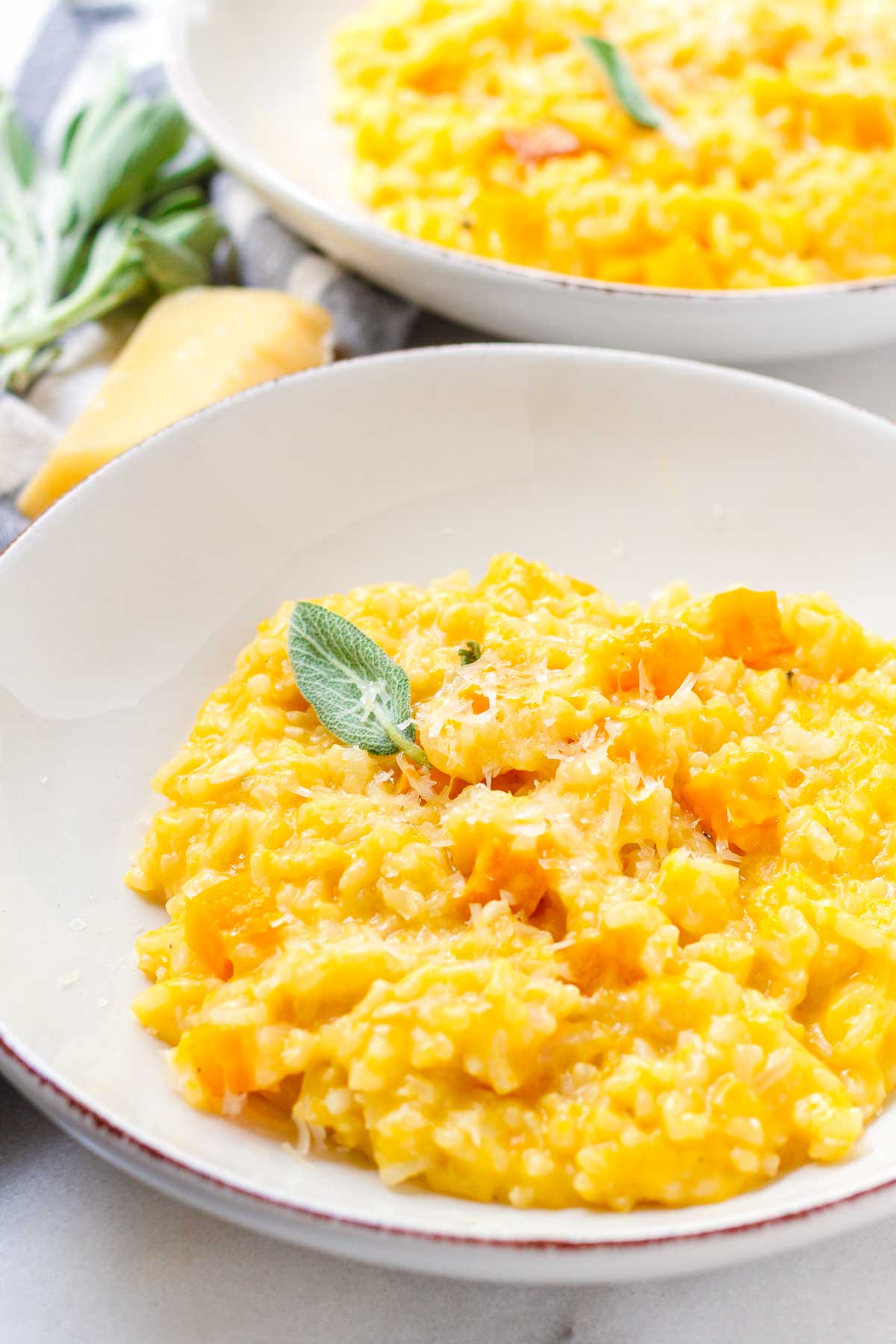
Recommended Types of Rice
As mentioned above, the best rice for risotto is arborio. You can find it at most grocery stores and probably online too. It looks like small, oval-shaped pearls. It’s a short-grain rice with high starch content. Because of this, it gets creamy as it cooks and absorbs all the liquid. Stirring constantly is what releases this starch.
Some recipes call for any type of short-grain rice, which is an acceptable substitution. However, arborio will give you the best results.
Do NOT use long grain rice, as it’s lower in starch and doesn’t absorb liquid as well as short-grain rice does.
How to Cut Butternut Squash
To make this butternut squash risotto recipe, you’ll roast diced butternut squash in the oven for 30 to 35 minutes so it’s tender and flavorful enough to make a puree. You can do this step up to 2 days ahead.
To cut butternut squash, all you need is a sharp knife and a vegetable Y-peeler!
Here’s how to cut a butternut squash:
- Cut off the top ends of the squash.
- Use a vegetable peeler to peel off the skin. It should come off easily.
- Split the peeled squash into 2.
- Scrape out the seeds with a spoon.
- Cut the squash into slices.
- Then, dice into cubes.

Shortcut: You can also roast frozen butternut squash, which is very convenient. Roast the frozen diced squash (do not thaw) with a few drizzles of olive oil, salt, and pepper at 450 degrees F until tender.
Ingredient Notes
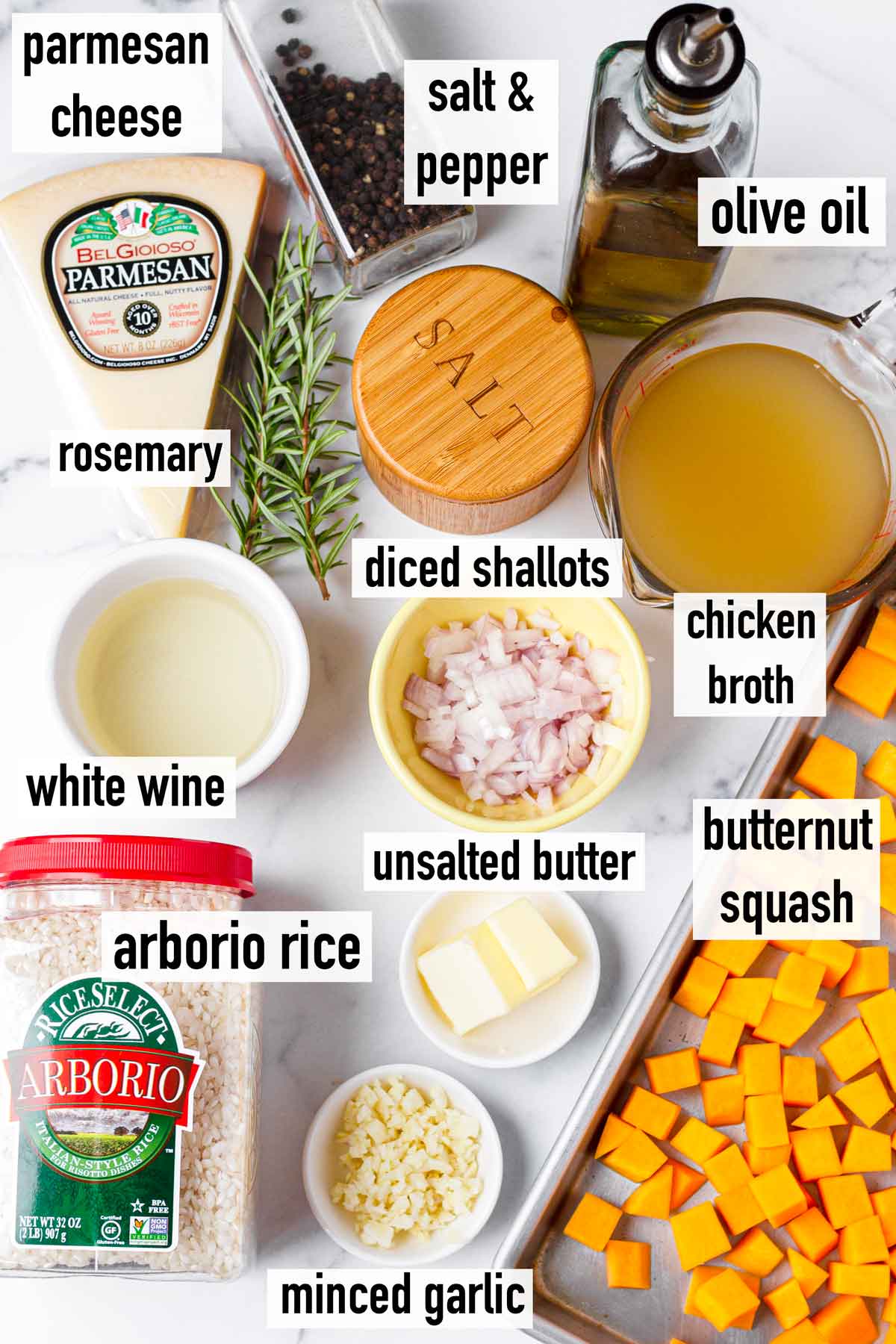
Here are a few helpful ingredient notes. The full ingredient list and quantities can be found in the recipe card down below.
- Butternut squash: Peeled and cut into ½ inch cubes. See above for a quick guide on how to cut butternut squash. You’ll roast the squash and then puree it.
- Olive oil, salt, pepper
- Shallot: While you could use diced onions, shallots have a more delicate and sweet flavor.
- Minced garlic and fresh minced rosemary are used for the aromatics base, along with the shallots.
- Unsalted butter: Adds a nice touch of richness and flavor, a little bit nutty.
- Arborio rice: This is a short-grain rice. It looks like small oval-shaped pearls. It’s high in starch, so it gets creamy and tender when it’s cooked.
- Dry white wine, such as Sauvignon Blanc. It adds a subtle flavor that you can’t miss. You only need half a cup.
- Vegetable or chicken broth: Used for cooking and stirring the rice. Make sure to warm up the broth. This keeps the rice temperature consistent and cooks the arborio rice more evenly.
- Freshly grated parmesan cheese: What is risotto without cheese anyway? Don’t use bagged pre-shedded parmesan, as it comes with added starches that make it hard to melt.
Step-by-Step Instructions
Here’s a helpful step-by-step tutorial on how to make butternut squash risotto at home.
Step 1 | Make butternut squash puree
Preheat oven to 425 degrees F. Arrange the butternut squash on a large sheet pan and toss with a few drizzles of olive oil, salt and pepper. Roast for about 30 to 35 minutes, until softened, tossing halfway through.
Set aside ½ cup of roasted butternut squash for garnish later. Let cool slightly and process the rest in a food processor to form a smooth puree. Set aside.

Step 2 | Saute aromatics
In a large deep pan, heat 1 tablespoon of olive oil over medium heat. Add the shallots, garlic, and minced rosemary, and saute for about 2 minutes until fragrant.
I use this 3.6-quart cast iron braiser. It retains heat pretty well and it’s the perfect size. You can also use a nonstick saute pan or a stainless steel pan.
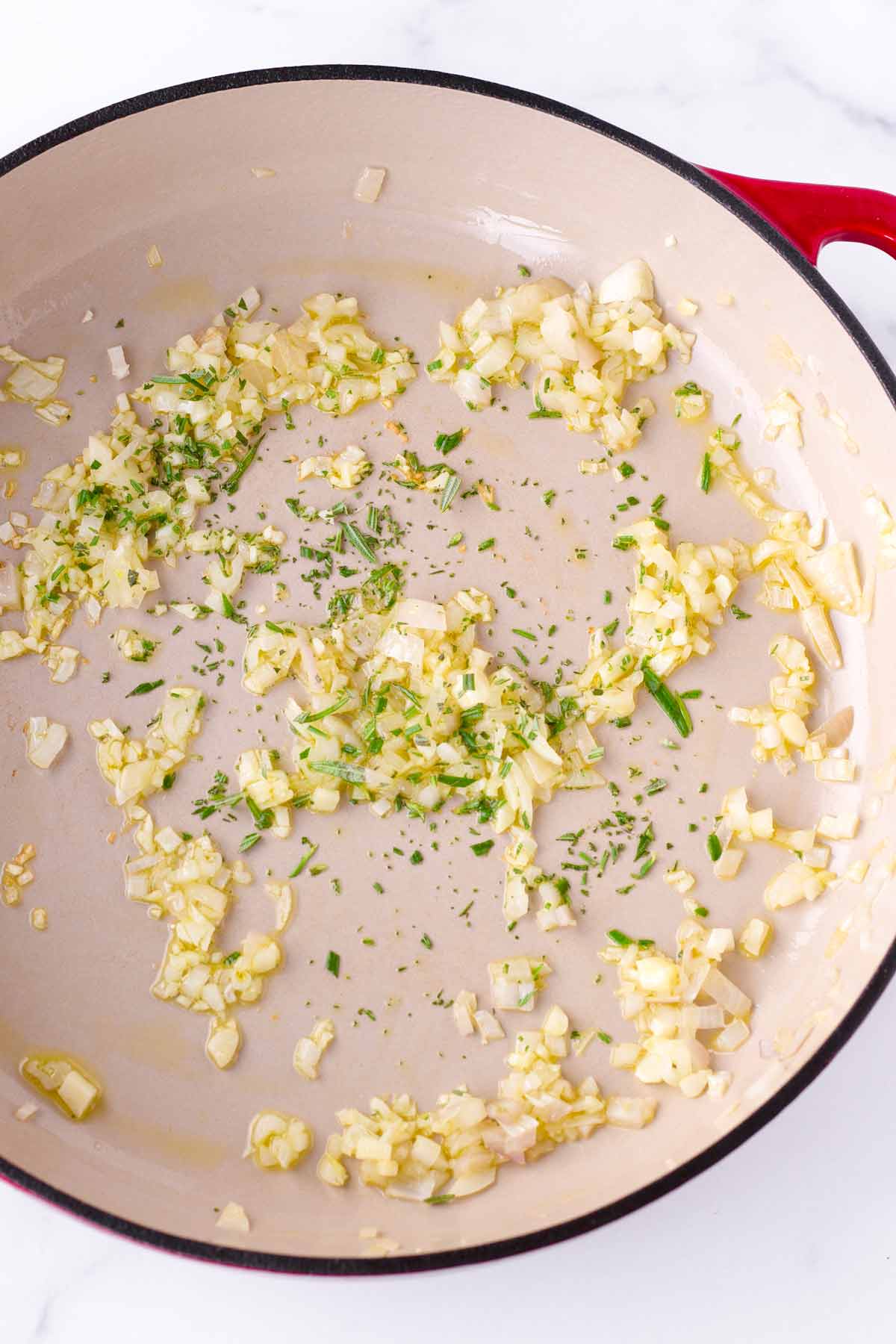
Step 3 | Add rice and wine
Add butter and arborio rice and stir until it starts to smell a little bit nutty and fragrant. Then, stir in the wine and cook until most of the wine has evaporated, about 2-3 minutes, stirring occasionally.
Tip: Do NOT rinse the rise prior to using. The key to a good risotto is releasing all that starch, and rinsing removes starch.
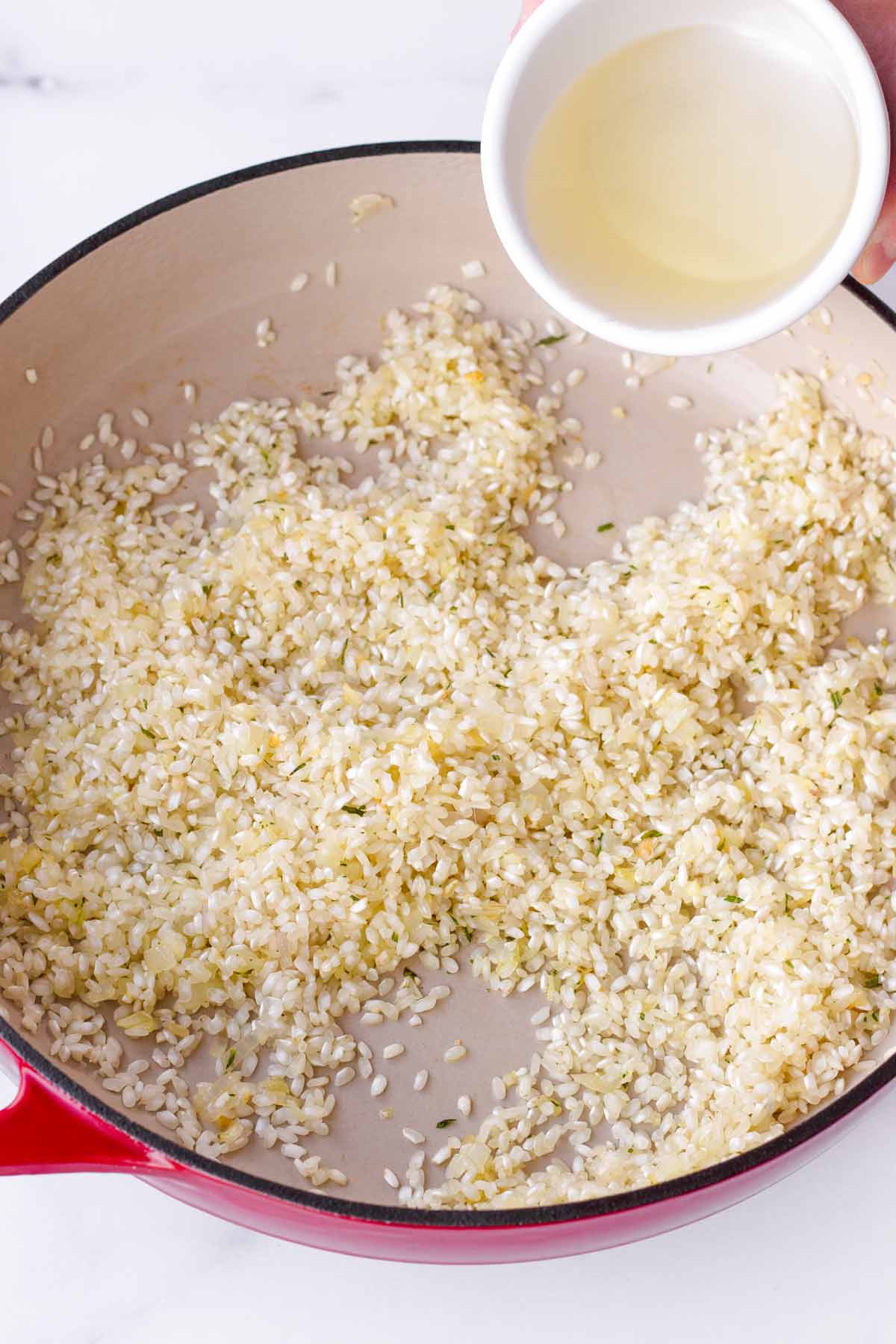
Step 4 | Add broth and stir
Add 1 cup of broth, stirring constantly with a wooden spoon. You don’t have to stir vigorously. After the liquid has absorbed into the rice, add another cup of warm broth and repeat the stirring process. Repeat with the remaining liquid until the rice is creamy and tender but still a little bit al dente in the center. This should take about 20 to 25 minutes.
Why use warm broth: For the rice to cook properly and evenly, avoid drastic changes in temperature. Pre-warming (do not boil) the broth keeps the rice at a steady temperature, which is essential for a smooth texture.
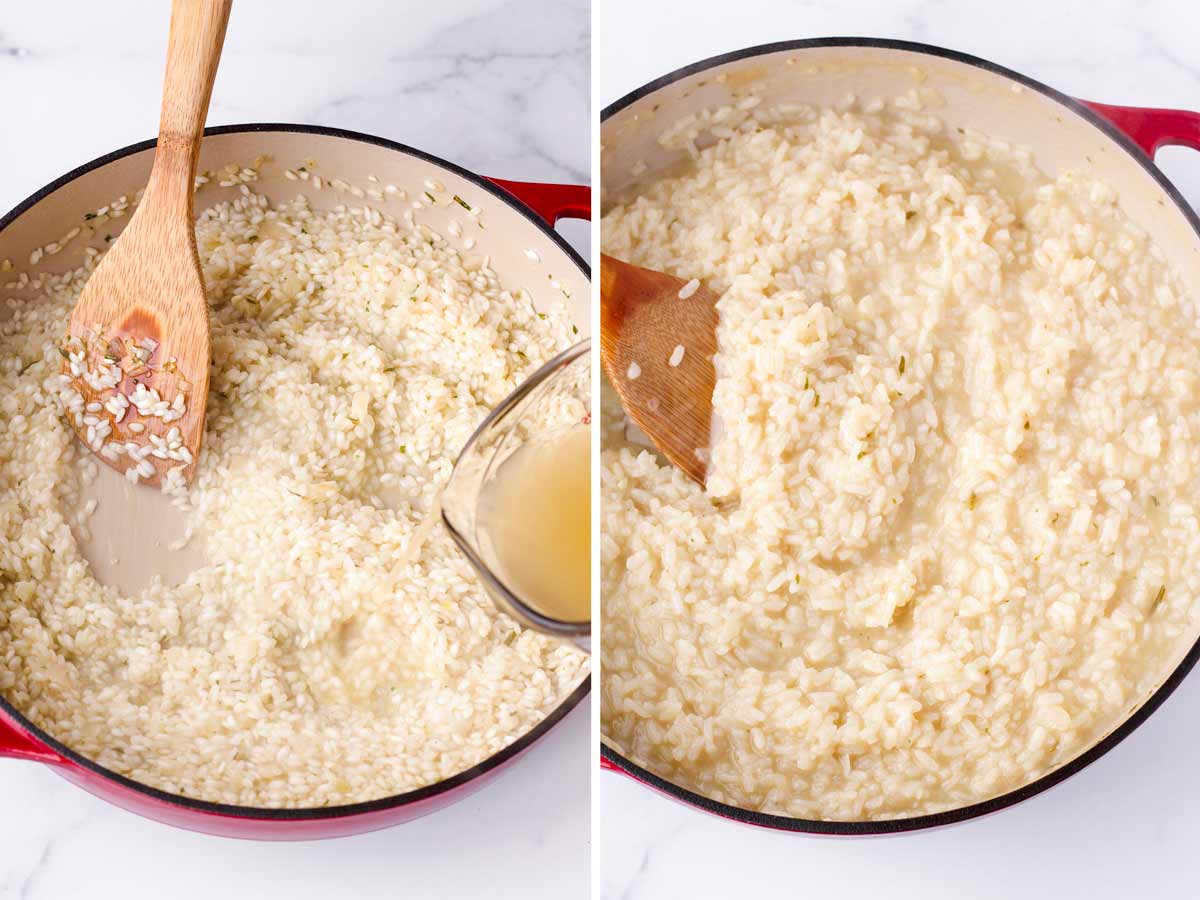
Step 5 | Stir in butternut squash and cheese
Once it’s ready, stir in the prepared butternut squash puree and freshly grated parmesan cheese. Cook for another 1 to 2 minutes, stirring until incorporated. Garnish with grated cheese and herbs.
How to tell when risotto is ready: It’s ready when it’s tender but has a very slight chew in the center (al dente).
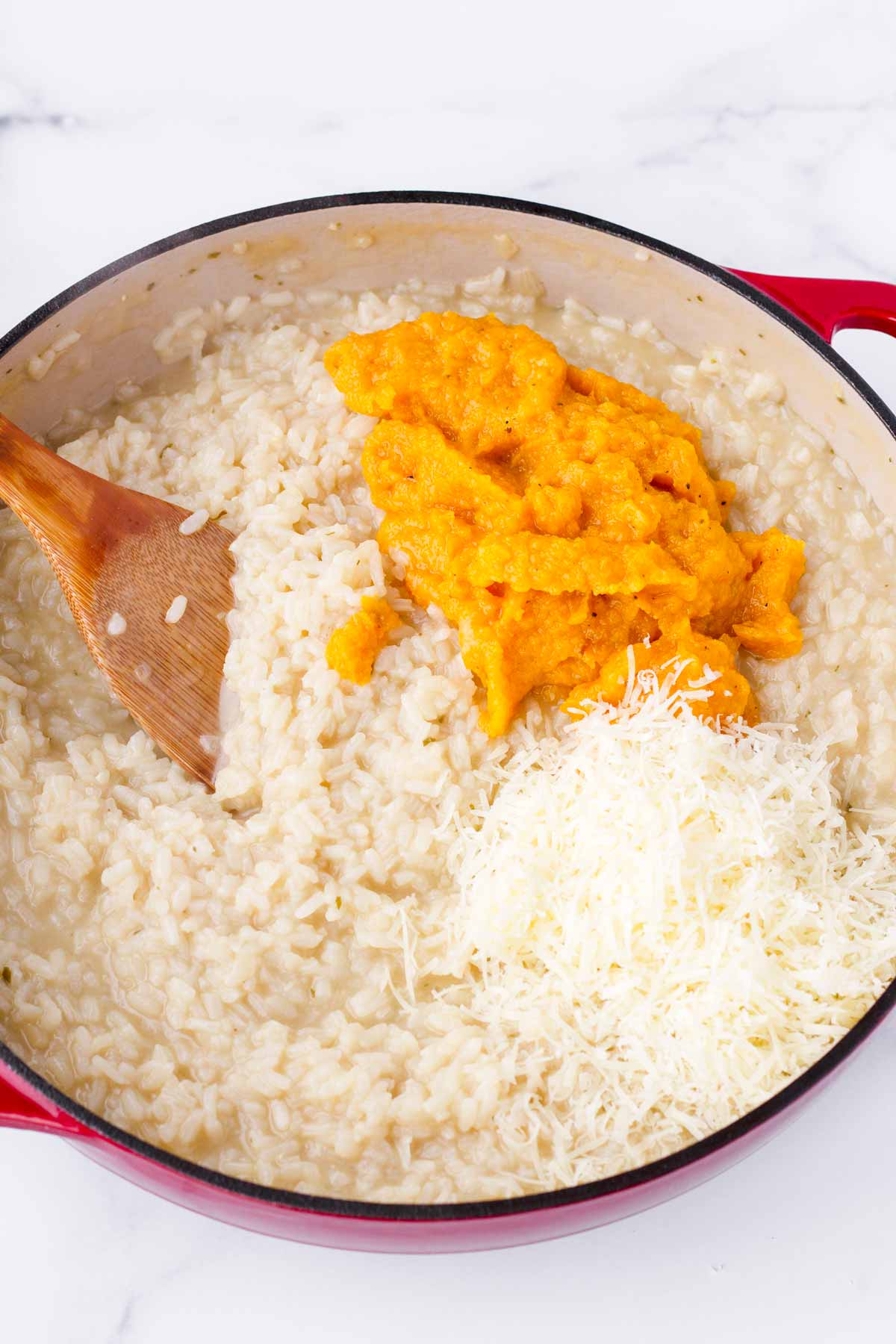
How to Reheat Risotto
Risotto is best served immediately because that’s when you can taste its creaminess and smooth texture. Once it cools down or gets refrigerated, the rice will continue to absorb the liquid and it will lose some of its creaminess.
For best results, if you have leftover butternut squash risotto, reheat it over the stovetop. Stir in a few splashes of broth as it reheats – this will bring back some of that creaminess. Also, add a handful of freshly grated parmesan cheese to make it extra creamy.
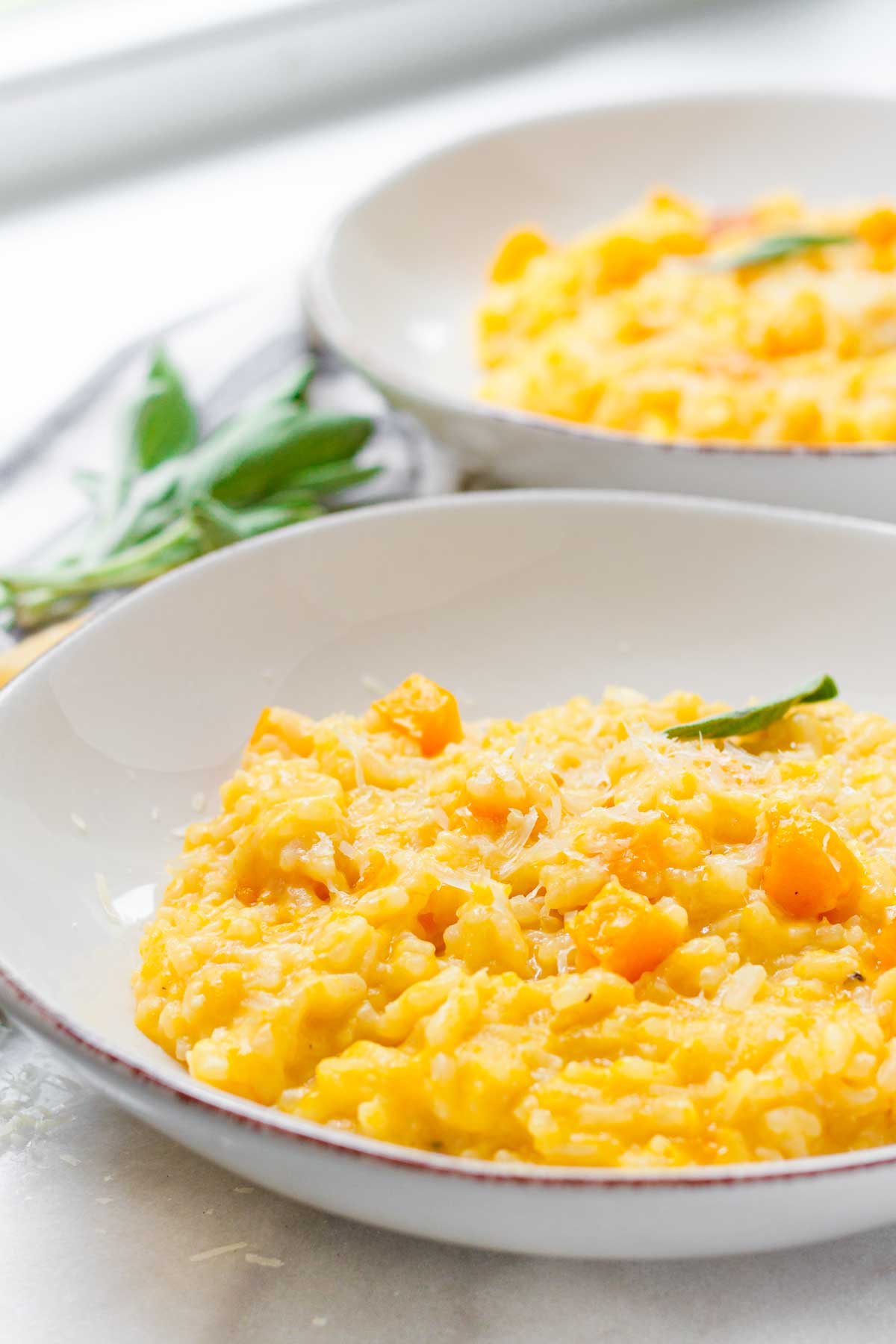
Prep Ahead
One thing that you can prep in advance is the butternut squash. Roast and puree the butternut squash and refrigerate for up to 2 days. Prior to using, warm it up a bit in the microwave oven so it incorporates into the rice more easily.
I would not recommend making the entire dish ahead of time. This is the kind of dish that is best served immediately. Once it cools down or gets refrigerated, the rice will continue to absorb the liquid, losing its creaminess.
However, you can still opt to make it ahead. Just reheat it per the instructions in the “How to Reheat Risotto” section above. It may not have the exact same texture as fresh, but if you follow these tips, it will still be delicious and creamy!

Pairing and Serving Ideas
I love serving this beautiful butternut squash risotto as the main dish. It’s its chance to shine. Pair it with roasted veggies or a simple arugula salad.
You can also serve it as a side dish! It goes really well with grilled steak, pan-seared apple pork chops, salmon, chicken…really anything. My favorite way to serve butternut squash risotto as a side is with a medium-rare steak and roasted parmesan asparagus.
Here are other seasonal fall dishes you’ll love:
Recipe FAQs
Yes, it is absolutely necessary. The stirring process is what releases the starch from the arborio rice, which creates that creaminess. Without stirring, the rice will not be creamy.
The best type of rice to use for this butternut squash risotto is arborio, which is a short-grain rice with a high amount of starch. As it cooks, the rice releases starch, which is what creates that unique texture.
Yes, up to 2 days in advance stored in the fridge. Prior to using, reheat it just a little bit in the microwave oven so it incorporates more easily into the rice.
Risotto is best served immediately because that’s when you can taste its creaminess and smooth texture. As it cools down, the rice continues to absorb the liquid, losing its creaminess. However, you can still make it ahead and reheat it with extra splashes of broth, although it may not be as creamy.
Always reheat over the stovetop over medium heat. Add a few splashes of broth and stir for a few minutes. This will bring back some of that creaminess. Then, add a handful or two of freshly grated parmesan cheese for even more creaminess.
This recipe was published in 2019 and updated in October 2022 to include new photos and information, plus a few recipe modifications.
Tips for Success
- Do NOT rinse the arborio rice. Rinsing removes the starch, and we need all the starch to achieve the right consistency.
- Warm up the broth (but do not boil) before adding to the rice. This helps to maintain a constant temperature as the rice cooks, which helps with consistency and texture.
- Stir, stir, stir constantly as you add the broth. That’s the key to creaminess. Sometimes, it takes one less or one more cup of broth. Taste for doneness as you go.
- Risotto is ready when it’s tender but has a very slight chew in the center (al dente).
- While you do need to stir constantly, there’s no need to stir vigorously. Over-doing or overcooking can make the rice gluey.
- If you can’t find arborio rice, use other types of short-grain rice, but arborio will get you the best results. No matter what, do not use long-grain rice, such as jasmine or basmati.
- Use freshly grated parmesan cheese. Pre-shredded cheese contains extra starches that could make the dish grainy.
I’d love to hear from you! If you loved my recipe, please consider leaving a 5-star rating and a comment down below. Sign up for my newsletter and follow along on Instagram, Facebook, or Pinterest
Butternut Squash Risotto
Equipment
- Enameled cast iron braiser 3.6 quart
- 3-quart nonstick saute pan if not using braiser
Ingredients
- 3 cups diced butternut squash - peeled and cut into ½ inch cubes
- Salt and pepper to taste
- Olive oil
- 1 small shallot, finely minced
- 3 cloves fresh garlic, finely minced
- 1 teaspoon minced fresh rosemary
- 2 tablespoons unsalted butter
- 1 ½ cups arborio rice - do NOT rinse
- ½ cup dry white wine - such as Sauvignon Blanc
- 4 to 5 cups chicken or vegetable broth, plus more as needed - warmed up a bit, but not boiled
- 1 cup freshly grated parmesan cheese, plus more to taste - do not use pre-shredded
Instructions
Make the butternut squash puree
- Preheat oven to 425 degrees F.
- Arrange the cubed butternut squash on a large sheet pan, and toss with about 2 tablespoons of olive oil, salt and pepper. Roast the butternut squash for 30-35 minutes, tossing halfway through.
- Let cool slightly, and set aside about ¼ cup for garnish later. Transfer the rest to a food processor and process for a few seconds until you get a smooth puree. Set aside.
Make the risotto
- In a 3-4 quart saute pan or pot, heat 1 tablespoon olive oil over medium heat. Saute the minced shallot and garlic for 2 minutes, and then add minced rosemary, and saute for 1 more minute until fragrant.
- Melt 2 tablespoons of unsalted butter and add the arborio rice (do not rinse rice). Stir until the rice is fragrant and smells a bit nutty, about 2 to 3 minutes. Then, stir in the white wine and cook until most of the wine has evaporated, stirring.
- To the rice, add 1 cup of broth, stirring constantly with a wooden spoon (no need to stir vigorously though). After the liquid has almost absorbed into the rice, add another cup of broth and repeat the stirring process. Do this with the remaining broth or as needed. Risotto is ready when it’s tender but has a very slight chew in the center (al dente). Note: During the last 2 instances, it will look much creamier. This process should take about 20 to 25 minutes.
- Add the butternut squash puree, grated parmesan, and salt and pepper to taste. Stir for another 1-2 minutes over low heat, until fully incorporated.
- Garnish with more cheese and some of that reserved roasted butternut squash. Enjoy!
Notes
- Do NOT rinse the rice. We need all the starch in the arborio rice to get the right texture.
- How to tell if risotto is ready: It’s ready when it’s tender but has a very slight chew in the center (al dente). Do not overcook or stir too vigorously, as this can make the rice glue-y and mushy.
- Use freshly grated parmesan cheese. Pre-shredded cheese contains extra starches that could affect the texture.
- You can use frozen cubed butternut squash, for convenience. Roast at 450 degrees F.
- Prep ahead: The butternut squash puree can be made up to 2 days in advance and refrigerated. Warm it up in the microwave oven before using.
- Make ahead? I would NOT recommend making risotto in advance. As the rice cools down, it continues to absorb the liquid, removing that creaminess. It’s best served fresh.
- Store leftovers in an airtight container. Refrigerate for up to 3 to 4 days.
- Reheat over the stovetop. Add a few splashes of broth and stir for a few minutes. This will bring back some of that creaminess. Stir in a handful of freshly grated parmesan cheese for even more creaminess.
- Arborio rice: Use other types of short-grain rice. Do not use long-grain rice, such as jasmine or basmati. However, I’d highly recommend arborio, as it contains a high amount of starch, which is perfect for achieving that creamy texture.
- Wine: Omit, if desired. Or use any type of dry white wine, such as Sauvignon Blanc, Pinot Grigio. Do NOT use red wine.


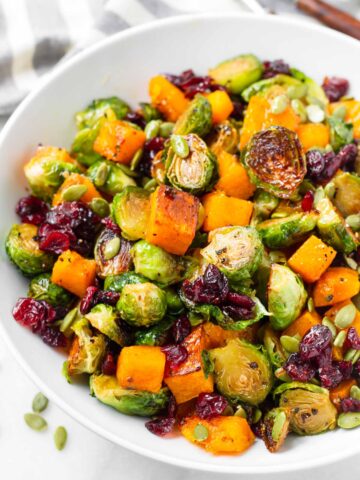
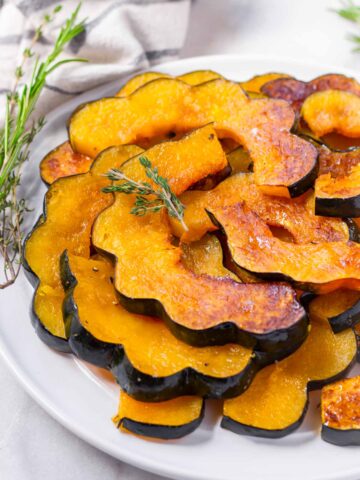
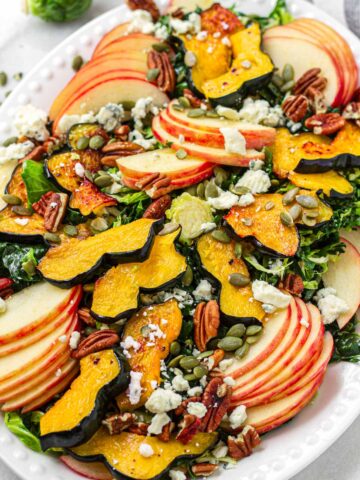




Leave a Reply